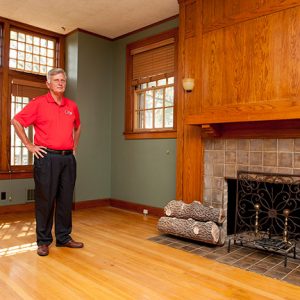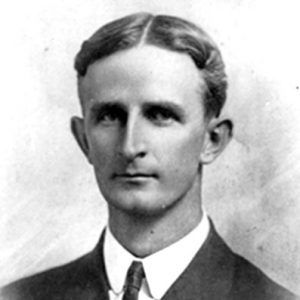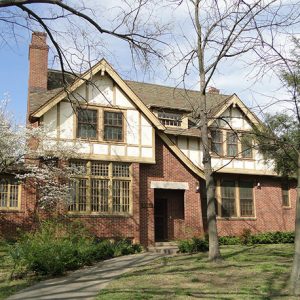calsfoundation@cals.org
Kays House
The historic residence of Victor Cicero (V. C.) Kays, who led the early development of what is now Arkansas State University (ASU), occupies a prominent rise along Aggie Road on the eastern side of the campus in Jonesboro (Craighead County).
Kays was the first president of the First District State Agricultural School—which later became Arkansas State College, then Arkansas State University—from appointment in 1910 until retirement in 1943. In the later years of his presidency, around 1936, he and his wife, Bertie, began construction of a three-story residence near the edge of the campus. Kays hired Little Rock (Pulaski County) architect A. N. McAninch to design the house, which includes bedrooms on the top floor, living and dining spaces on the main floor, and a full basement. Kays knew McAninch through his work designing the college’s early buildings, including four erected during the 1930s that still stand in the twenty-first century: Administration Building (now R. E. Lee Wilson Hall), Student Commons Building (now College of Nursing and Health Professions), Science Building (now College of Business), and Teacher Training School (now Department of Mathematics and Computer Science).
McAninch designed the house in a Tudor style, possibly as an indirect result of Kays’s association with the politically and socially prominent Wilson family of Wilson (Mississippi County). R. E. Lee Wilson was a trustee of the institution from 1917 until his death in 1933, and he gave extensive support to the school during its formative years. Wilson’s son Roy developed an affinity for the Tudor architectural style during a vacation he and his wife took in England in 1922–23. He later built a Tudor-style mansion and added Tudor façades to the company-owned facilities in Wilson.
Kays and his wife continued to live in the house through the remainder of his presidency, a brief period as president emeritus and college business manager, and retirement. Kays died in 1966. His son, V. H. (Buddy) Kays, moved back to Jonesboro after retiring from a federal government career and lived in the house until his death in 2001.
ASU later acquired the property from the Kays estate as part of a larger tract. Some years later, as the university planned construction of a row of sorority houses, the Kays House was marked for demolition. However, current and retired faculty and historic preservation advocates voiced opposition and asked the university to preserve the house to recognize Kays’s importance to the institution’s history. Dr. Tim Hudson, the chancellor, supported the formation of a committee of faculty and community leaders to raise money and organize broad support for preservation, with Dr. Clyde Milner, director of the Heritage Studies PhD program at ASU, as committee chair. Eventually, the university administration re-worked the site plan to leave the Kays House where it stands in the midst of sorority row and began restoration of the house exterior using funds from private gifts the committee raised.
In May 2014, the Arkansas Natural and Cultural Resources Council approved a grant of $200,000 for major exterior restoration, including waterproofing basement walls, installing a drainage system, repairing the tile roof, and replacing gutters and downspouts. Based on a nomination by the Arkansas Historic Preservation Program, the Kays House was added to the National Register of Historic Places in June 2014, becoming the first property at ASU on the list.
Mike Beebe, a 1968 alumnus of ASU and former chair of its board of trustees, announced on September 20, 2014, his plan to donate to the university his official papers, photographs, video, and memorabilia from his two terms as governor of Arkansas. Areas of the Kays House will be available to “establish interactive presentations of the governor’s legacy in public service.” Beebe also planned to donate furnishings and several personal items to re-create his Arkansas State Capitol office in the Kays House living room, which has almost exactly the same dimensions and layout. ASU will establish the Governor Mike Beebe Economic Development and Education Institute and develop a website for access to the collections.
The successful effort to save the V. C. Kays House was recognized on January 9, 2015 at the annual Arkansas Preservation Awards sponsored by the Historic Preservation Alliance of Arkansas (now Preserve Arkansas). Dr. Scott Darwin, emeritus professor of German at ASU, received the Award for Outstanding Achievement in Preservation Advocacy for championing preservation of the 1936 home.
The university’s long-term plans to develop the Kays House as a heritage site also include educational exhibits about the impact of V. C. Kays and his presidency, as well as the importance his friend and political ally, U.S. senator Hattie Caraway, who was influential in acquiring federal building funds for the college during its darkest days.
For additional information:
Ball, Larry D., and William M. Clements. Voices from State: An Oral History of Arkansas State University. Jonesboro: Arkansas State University, 1984.
Dew, Lee A. The ASU Story: A History of Arkansas State University, 1909–1967. Jonesboro: Arkansas State University Press, 1968.
Hendricks, Nancy. Dear Mrs. Caraway, Dear Mr. Kays. Jonesboro, AR: 2010.
“Victor Cicero Kays House.” National Register of Historic Places nomination form. On file at Arkansas Historic Preservation Program, Little Rock, Arkansas. Online at http://www.arkansaspreservation.com/National-Register-Listings/PDF/CG0276.nr.pdf (accessed September 13, 2021).
Whayne, Jeannie. Delta Empire: Lee Wilson and the Transformation of Agriculture in the New South. Baton Rouge: Louisiana State University Press, 2011.
Thomas Moore
Arkansas State University

 Mike Beebe at Kays House
Mike Beebe at Kays House  Victor Kays
Victor Kays  Kays House
Kays House 



Comments
No comments on this entry yet.